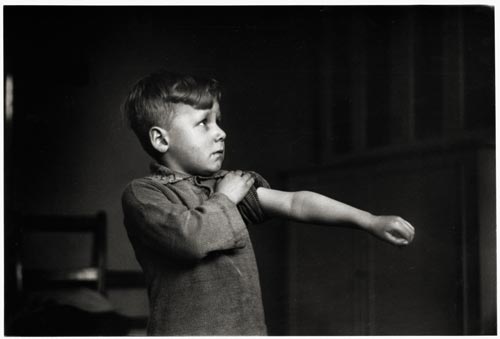The Lost Art Of The Simple
I just managed to catch the Denis Thorpe exhibition “A View From The North” at Stockport’s War Memorial Art Gallery before it closed. It was a fairly standard display: 97 photographs arranged in a long line right around the room, all much the same size and all in fairly standard frames. They were mostly giclee prints with one or two silver gelatin. 95 were black and white and two were in colour – though those two were themselves reproduced in black and white in the book of the exhibition (available from Bluecoat Press)
You might expect an exhibition of press photographs from the second half of the twentieth century to have the subtitle: Here Today And Gone Tomorrow – because that is what most news photos are. They illustrate events which quickly disappear into history. Yet Denis Thorpe’s work is proving to have an unusual staying power (this exhibition itself following on from one at The Lowry in 2001).
Diptheria Immunisation Programme by Denis Thorpe
He worked on local newspapers before moving to the Daily Mail in 1957 and then the Guardian in 1974. He had been inspired in his career path by the photojournalists of the generation before his own – those who worked for Life, Picture Post and Vu. Maybe that gives a clue to the longevity of his work because they aren’t really images designed primarily to illustrate a news story. They tell a story in their own right, in the wordless way that photographs do.
If we take the photograph above as an illustration, we see a timeless image of a young boy approaching what we might call a rite of passage consisting of a painful experience visited on him by well-meaning adults. This is the universal celebrated in the particular. I can just recall my own diphtheria vaccination and the trepidation I felt just like this young man. The composition is the simplest imaginable – just the rectangle of the boy’s body, the circle of his head and the horizontal line of his arm. We might also these days be inclined to impose an NHS backstory on the photograph. In 1954 when it was taken the NHS was in its early days and its national significance was rightly celebrated in an image like this. And now? The simple truth illustrated by the picture, of the value of universal access to good healthcare, seems to have been lost. So it is hard to imagine a modern equivalent of this picture.
Calling the exhibition “A View From The North” sells it a little bit short. Many of the photographs were taken in northern England but there are plenty from elsewhere: Spain, India, Japan, Egypt, Russia, the USA, and Belfast and other parts of the UK. What holds it together as an exhibition in my opinion is not so much the geography or northern culture as the style. The subject matter is unassuming and detail has been closely observed. There are haircuts, violin lessons, playground games, a great grandmother cradling her great granddaughter. These are events still today happening all the time, all around us. They are still points in a turning world.
The turning world, it might be said, has moved on. We see simplicity as being the characteristic of a past age. I would be more inclined to say that it is a way of seeing which has largely slipped from our grasp. It is there for those who choose to retrieve it and photography is one way of doing that.
